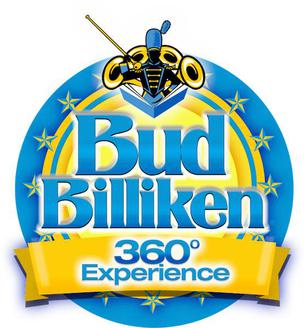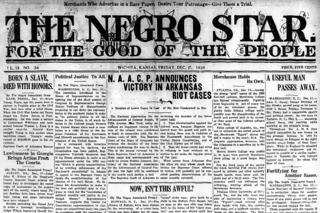
Robert Sengstacke Abbott was an American lawyer, newspaper publisher and editor. Abbott founded The Chicago Defender in 1905, which grew to have the highest circulation of any black-owned newspaper in the country.

The Iowa Bystander was an Iowa newspaper targeted toward an African American audience. It was founded in Des Moines on June 15, 1894, by I.E. Williamson, Billy Colson, and Jack Logan, and it is considered to be the oldest Black newspaper west of the Mississippi. The paper was first called Iowa State Bystander; the term "bystander" given by its editor, Charles Ruff, after a syndicated column "The Bystander's Notes" written by Albion W. Tourgée, a civil rights advocate who wrote for The Daily Inter Ocean. The name was changed to Bystander in 1916 by owner John L. Thompson, who published the paper from 1896-1922. Thompson traveled around the state seeking new subscribers, raising the circulation to 2,000 copies, and changed the paper to a 6-column 8-page layout.
The New Pittsburgh Courier is a weekly African-American newspaper based in Pittsburgh, Pennsylvania, United States. It is owned by Real Times.

Ethel Lois Payne was an American journalist, editor, and foreign correspondent. Known as the "First Lady of the Black Press," she fulfilled many roles over her career, including columnist, commentator, lecturer, and freelance writer. She combined advocacy with journalism as she reported on the Civil Rights Movement during the 1950s and 1960s. Her perspective as an African American woman informed her work, and she became known for asking questions others dared not ask.
The Michigan Chronicle is a weekly African-American newspaper based in Detroit, Michigan. It was founded in 1936 by John H. Sengstacke, editor of the Chicago Defender. Together with the Defender and a handful of other African-American newspapers, it is owned by Detroit-based Real Times Inc. Its headquarters are in the Real Times offices in Midtown Detroit.

The Bud Billiken Parade and Picnic is an annual parade held since 1929 in Chicago, Illinois. The Bud Billiken Day Parade is the largest African-American parade in the United States. Held annually on the city's south side on the second Saturday in August, the parade route travels on Dr. Martin Luther King Drive through the Bronzeville and Washington Park neighborhoods. At the end of the parade, in the historic Washington public park is a picnic and festival. Robert S. Abbott, the founder and publisher of the Chicago Defender newspaper, created the fictional character of Bud Billiken, which he featured in a youth advice column in his paper. David Kellum, co-founder of the newspaper sponsored Bud Billiken Club and longtime parade coordinator suggested the parade as a celebration of African-American life.

Lincoln Cemetery is a historically African American cemetery in Blue Island, Illinois, United States. The cemetery is about 112 acres (45 ha) with over 16,000 interments.

African American newspapers are news publications in the United States serving African American communities. Samuel Cornish and John Brown Russwurm started the first African American periodical, Freedom's Journal, in 1827. During the Antebellum South, other African American newspapers sprang up, such as The North Star, founded in 1847 by Frederick Douglass.
Real Times Media LLC is the owner and publisher of the Chicago Defender, the largest and most influential African American weekly newspaper, as well as five other regional weeklies in the eastern and Midwestern United States. Its headquarters are in Midtown Detroit.

John Herman Henry Sengstacke was an American newspaper publisher and owner of the largest chain of African-American oriented newspapers in the United States. Sengstacke was also a civil rights activist and worked for a strong black press, founding the National Newspaper Publishers Association in 1940, to unify and strengthen African-American owned papers. Sengstacke served seven terms as president of the association, which by the early 21st century had 200 members.
The Pittsburgh Courier was an African American weekly newspaper published in Pittsburgh from 1907 until October 22, 1966. By the 1930s, the Courier was one of the leading black newspapers in the United States.

John Henry Murphy Sr. was an African-American newspaper publisher based in Baltimore, Maryland. Born into slavery, he is best known as the founder of the Baltimore Afro-American, published by the AFRO-American Newspaper Company of Baltimore, Inc. This newspaper is one of the oldest operating black family-owned newspapers in the U.S.A.

The Negro Star was an African American newspaper created by Hollie T. Sims that ran from 1908 to 1953. Sims founded the paper in Greenwood, Mississippi, but moved it to Wichita, Kansas, in 1919 as a result of racial hostility. Bringing national news to Wichita, the Star was one of few newspapers that provided African Americans news and access to African-American updates during the early to mid-1900s.
Harry Sylvester McAlpin Jr. was an American reporter. He was the first African-American reporter to attend a U.S. Presidential news conference in 1944.

The Baltimore Afro-American, commonly known as The Afro or Afro News, is a weekly African-American newspaper published in Baltimore, Maryland. It is the flagship newspaper of the AFRO-American chain and the longest-running African-American family-owned newspaper in the United States, established in 1892.
The Chicago Defender is a Chicago-based online African-American newspaper. It was founded in 1905 by Robert S. Abbott and was once considered the "most important" newspaper of its kind. Abbott's newspaper reported and campaigned against Jim Crow-era violence and urged black people in the American South to settle in the north in what became the Great Migration. Abbott worked out an informal distribution system with Pullman porters who surreptitiously took his paper by rail far beyond Chicago, especially to African American readers in the southern United States. Under his nephew and chosen successor, John H. Sengstacke, the paper dealt with racial segregation in the United States, especially in the U.S. military, during World War II. Copies of the paper were passed along in communities, and it is estimated that at its most successful, each copy was read by four to five people.
The Houston Defender (Network) is a Black digital information source that originated from the African American newspaper of the same name based in Houston, Texas. Established in 1930 by C.F. Richardson Sr., the newspaper has been a strong voice for the African American community for over 90 years. During its founding, African Americans faced significant challenges, such as racism, discrimination and limited access to education, employment and political power. Today, the Houston Defender Network is pivotal in advocating for social, economic, environmental and political justice for the African American community.

Robert Abbott Sengstacke, also known as Bobby Sengstacke, was an African-American photojournalist during the Civil Rights Movement for the Chicago Defender in Chicago, Illinois. Sengstacke was well known for his famous portraits of Martin Luther King Jr. and other prominent civil rights leaders. Sengstacke inherited the family–owned Sengstacke Newspaper Company. After retiring from journalism in 2015, Sengstacke moved to Hammond, Indiana where he lived until his death due to a respiratory illness in 2017 at age 73.
Claude Albert Barnett was an American journalist, publisher, entrepreneur, philanthropist, civic activist, Pan-Africanist, and founder of the Associated Negro Press (ANP). He started the first international news agency for black newspapers. He was an advocate against segregation in the military and blood supply. He was an activist force in journalism. He promoted Pan-Africanism. The (ANP) documented the Civil Rights Movement in the United States of America, and struggles for independence in Africa. Associated Negro Press was a Pan-African news service. Claude Barnett, Robert S. Abbott, and John H. Johnson were three of the most influential African-American media entrepreneurs in the 20th century. They were based in Chicago, Illinois. Barnett is said to have advanced the role of the Black Press in press coverage, news sharing, advertising, public relations, and professionalism.
Frank L. Stanley Sr. was an American newspaper publisher and editor. Stanley co-founded and became sole publisher of The Louisville Defender, the city's leading Black newspaper that he led for 38 years. The Louisville Defender published in the face of regular threats and attacks, persevering under Stanley's belief that "racism is not insoluble." Stanley was general president of Alpha Phi Alpha and a civil rights activist. He drafted the resolution that led to desegregation of higher education in Kentucky, and chaired desegregation committees for the U.S. Secretary of War. Stanley was selected twice as a juror for the Pulitzer Prize Award committee.











